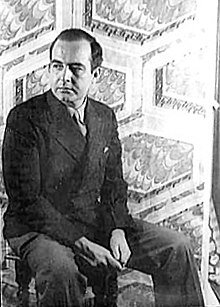Agnus Dei (Barber)
| Agnus Dei | |
|---|---|
| by Samuel Barber | |
 Samuel Barber, photographed by Carl Van Vechten, 1944 | |
| Key | B-flat minor |
| Year | 1967 |
| Text | Agnus Dei |
| Language | Latin |
| Based on | Adagio for Strings |
| Scoring | Choir SSAATTBB, optional piano or organ |
Agnus Dei (Lamb of God) is a
History
Barber's Adagio for Strings began as the second movement of his String Quartet,
Music
Graham Olson describes the composition for AllMusic. After reflecting the history and pointing out the Adagio's associations with mourning, nostalgia, love and passion, qualified as "sentimental Romanticism", he writes about the choral setting: "Barber brought to the surface the work's sense of spirituality." He observes similarities to works of the Renaissance by Palestrina and Gabrieli.[2] Violinist Phillip Ying says about the quartet movement: "The score looks so clear, like a counterpoint exercise, and the power of it is in the economy of means."[1]
Agnus Dei is in
The piece lasts about eight minutes.[2] The accompaniment is optional and only for support.
Recordings
The
References
- ^ a b Keller, Johanna (7 March 2010). "An Adagio for Strings, and for the Ages". The New York Times. Retrieved 7 March 2010.
- ^ a b c
Olson, Graham. Agnus Dei, for chorus (arr. from 2nd mvt. of String Quartet), Op. 11 at AllMusic. Retrieved 23 March 2012.
- ^
"Samuel Barber: Agnus Dei". G. Schirmer. 2010.
- ^
Heyman, Barbara B (1992). Samuel Barber: The Composer and His Music. ISBN 978-0-19-509058-1.
- ^
Agnus Dei / Samuel Barber, G. Schirmer, 1992[full citation needed]
- ^
Bernstein: Chichester Psalms; Copland: In the Beginning; Barber: Agnus Dei at AllMusic. Retrieved 23 March 2012.
- ^ "Agnus Dei, New College Choir, Oxford". Gramophone. 1997. Retrieved 23 March 2012.[permanent dead link]
- ^ "Samuel Barber (1910–1981) / Choral Music". Gramophone. 2006. Retrieved 23 March 2012.
- ^ "The Best Of Barber – Adagio For Strings, Agnus Dei, etc". arkivmusic.com. 2003. Archived from the original on 12 October 2016. Retrieved 23 March 2012.
- AllMusic
- ^ Live performance on YouTube, Rotterdam Symphony Chorus and Laurenscantorij, 2015, St. John's Cathedral ('s-Hertogenbosch)
External links
- Agnus Dei on YouTube, Barber's own choral setting performed a cappella by the Choir of Trinity College, Cambridge, conducted by Richard Marlow
